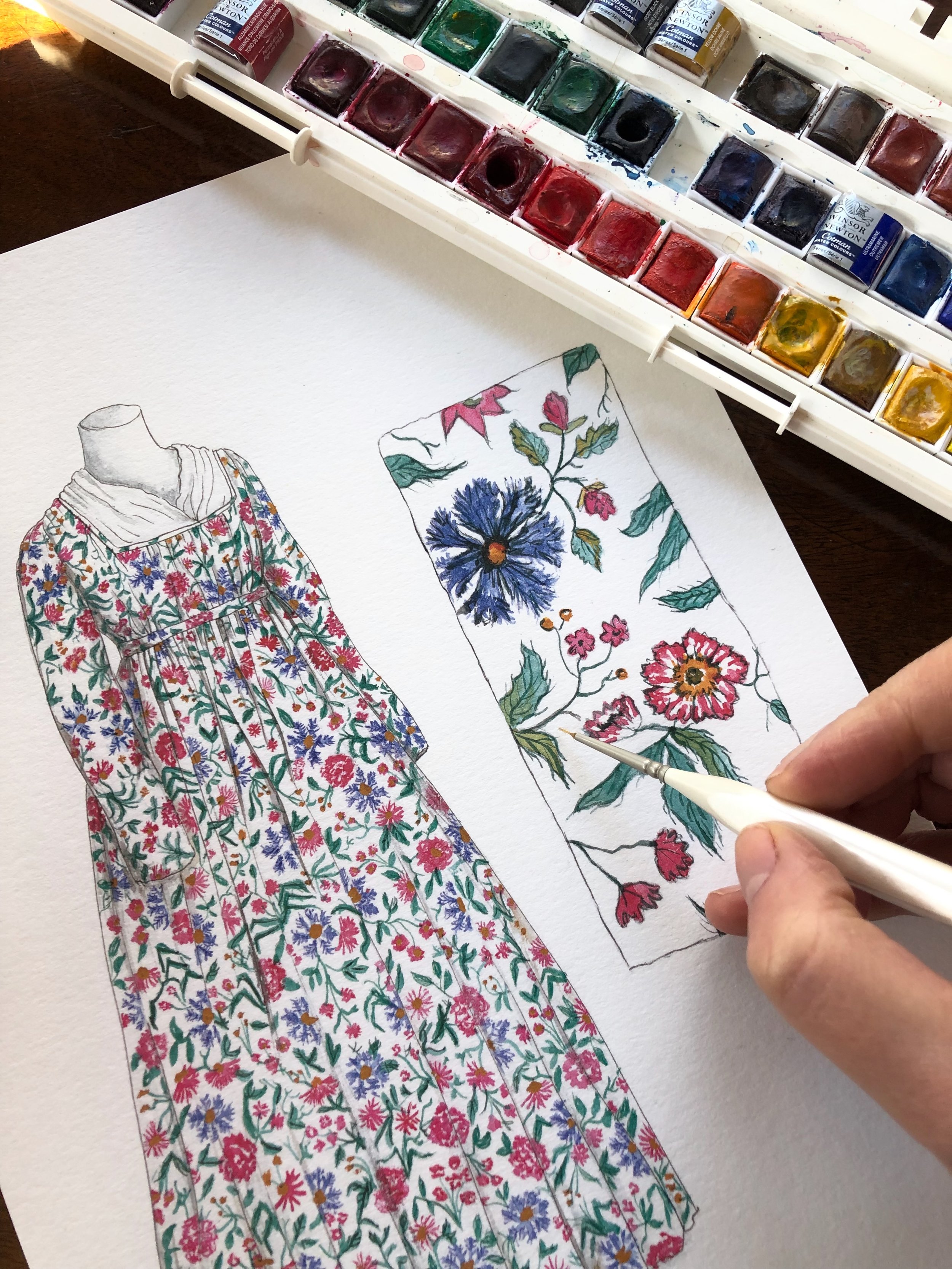 Image 1 of 3
Image 1 of 3

 Image 2 of 3
Image 2 of 3

 Image 3 of 3
Image 3 of 3




'1805 Gown Inspired by Fabric Found in the c.1811 Austen Quilt,' Signed Print - A4
Description and Historical Context
This pen, ink and watercolour illustration of an 1805 printed day gown has taken its inspiration from fabrics found in Jane and Cassandra Austen’s quilt, made c.1811 and now held at Jane Austen’s House Museum in Chawton, Hampshire.
During the early nineteenth century, printed cottons and fine muslins were often used in dressmaking. It is therefore feasible that some of those materials included in the Austen quilt were scraps leftover from gowns made and worn by Jane or Cassandra Austen or members of their family, in the years leading up to the making of the bedspread.
Dress historian and illustrator Eleanor Houghton, drawing on her detailed knowledge of early nineteenth century clothing and Jane and Cassandra Austen’s ‘written’ dress as described in their letters, decided to artistically recreate the kind of gowns that would have been made from the different printed fabrics found within the quilt.
By 1805, women's fashion had undergone significant transformation as it moved from the ornate styles of the Rococo era toward the simplicity and grace of the Regency aesthetic. This shift was influenced by the ideals of Ancient Greece and Rome and placed emphasis upon natural lines and understated elegance. Consequently, this gown features a high waist, long draping pleats. The pretty, printed floral fabric, which bears similarity to that found in the quilt, has a white ground and is peppered with cornflowers, dog roses and small pink blooms as well as a variety of deep, green leaves.
The original painting, along with three others from the series, is currently on display at Jane Austen’s House Museum, the house where Jane Austen lived and worked for a considerable portion of her life, including the period in which she wrote all of her most famous novels.
Specifications
Individually Signed by the Artist
297×210mm (A4) on Backing Board with Cellophane
Printed on Perlino Cotton Paper — Perlino is an FSC® certified board made up of 65% virgin fibres, 20% recycled material and 15% cotton fibres
Please note that this artwork is unmounted
Description and Historical Context
This pen, ink and watercolour illustration of an 1805 printed day gown has taken its inspiration from fabrics found in Jane and Cassandra Austen’s quilt, made c.1811 and now held at Jane Austen’s House Museum in Chawton, Hampshire.
During the early nineteenth century, printed cottons and fine muslins were often used in dressmaking. It is therefore feasible that some of those materials included in the Austen quilt were scraps leftover from gowns made and worn by Jane or Cassandra Austen or members of their family, in the years leading up to the making of the bedspread.
Dress historian and illustrator Eleanor Houghton, drawing on her detailed knowledge of early nineteenth century clothing and Jane and Cassandra Austen’s ‘written’ dress as described in their letters, decided to artistically recreate the kind of gowns that would have been made from the different printed fabrics found within the quilt.
By 1805, women's fashion had undergone significant transformation as it moved from the ornate styles of the Rococo era toward the simplicity and grace of the Regency aesthetic. This shift was influenced by the ideals of Ancient Greece and Rome and placed emphasis upon natural lines and understated elegance. Consequently, this gown features a high waist, long draping pleats. The pretty, printed floral fabric, which bears similarity to that found in the quilt, has a white ground and is peppered with cornflowers, dog roses and small pink blooms as well as a variety of deep, green leaves.
The original painting, along with three others from the series, is currently on display at Jane Austen’s House Museum, the house where Jane Austen lived and worked for a considerable portion of her life, including the period in which she wrote all of her most famous novels.
Specifications
Individually Signed by the Artist
297×210mm (A4) on Backing Board with Cellophane
Printed on Perlino Cotton Paper — Perlino is an FSC® certified board made up of 65% virgin fibres, 20% recycled material and 15% cotton fibres
Please note that this artwork is unmounted

